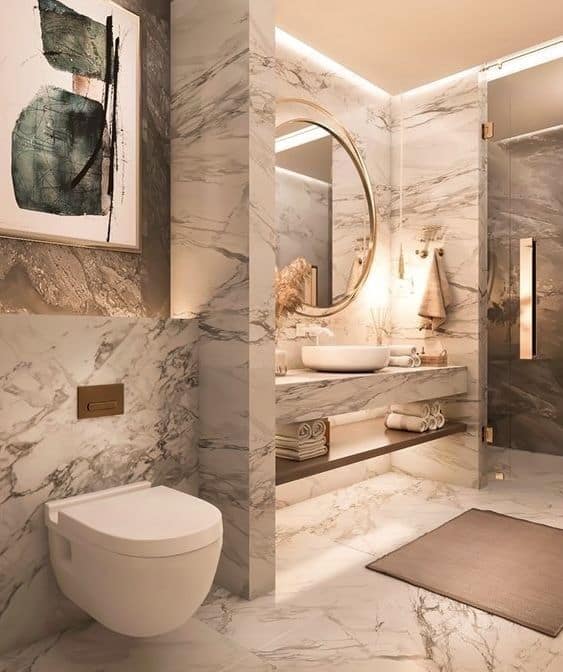Luxury bathrooms are more than just beautiful spaces — they’re sanctuaries. A place where light, texture, and proportion work together to slow your mind, calm your senses, and make the everyday feel special.
But what makes a bathroom truly luxurious? Is it marble? A freestanding tub? Or the way everything feels effortlessly in balance?
The truth is, luxury isn’t about cost — it’s about composition. The choices you make in materials, color, lighting, and layout all influence how a bathroom feels.
Below, you’ll find not only stunning examples of luxury bathroom design, but also the reasoning behind them — and how to achieve that look, no matter your space or budget.
Before You Begin: What Defines a “Luxury” Bathroom?

Luxury bathrooms are defined by comfort, craftsmanship, and calm. You’ll often see:
- High-quality, tactile materials (stone, wood, brass)
- Balanced proportions and symmetry
- A calming, neutral palette
- Layered lighting (not just one harsh overhead bulb)
- Spa-like features — rainfall showers, soaking tubs, soft textiles
But the secret ingredient? Intentionality. Every detail feels deliberate — nothing is accidental or purely decorative.
Ask yourself:
- What emotion do I want this space to evoke — calm, drama, or indulgence?
- How much natural light do I have?
- Where do I want the eye to go first when I walk in?
These questions guide every luxury designer’s process.
1. The Modern Marble Sanctuary
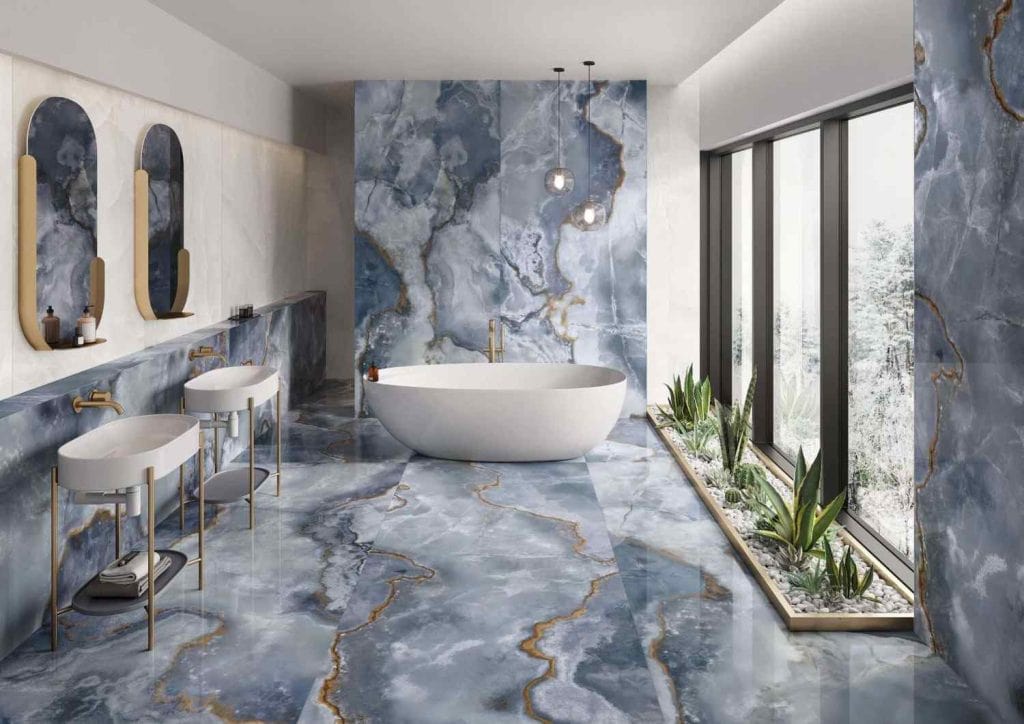
Marble has reigned supreme in bathroom design for centuries — but modern luxury is about how you use it. Today’s trend is to create visual continuity: wrapping floors, walls, and counters in the same veined slab for a sculptural, seamless look.
Why It Works: The eye reads one unified surface, making the space feel expansive and serene.
How to Recreate It:
- Use large-format slabs to reduce grout lines.
- Warm up the cool tones with brass, wood, or soft lighting.
- Add a soaking tub or floating vanity to break the monotony.
2. Spa-Inspired Serenity

A spa bathroom doesn’t shout luxury — it whispers it. Natural materials, indirect lighting, and calm tones are the key.
Design Philosophy: Every surface should engage the senses. Rough stone, smooth tile, soft towels — all balanced.
Pro Tip: Include something living (like a plant or bamboo) to soften hard edges.
Common Question:
Can small bathrooms feel spa-like?
Absolutely. Focus on texture and scent — eucalyptus, linen, or sandalwood — and add layered light instead of bright overhead fixtures.
3. The Black & Gold Statement
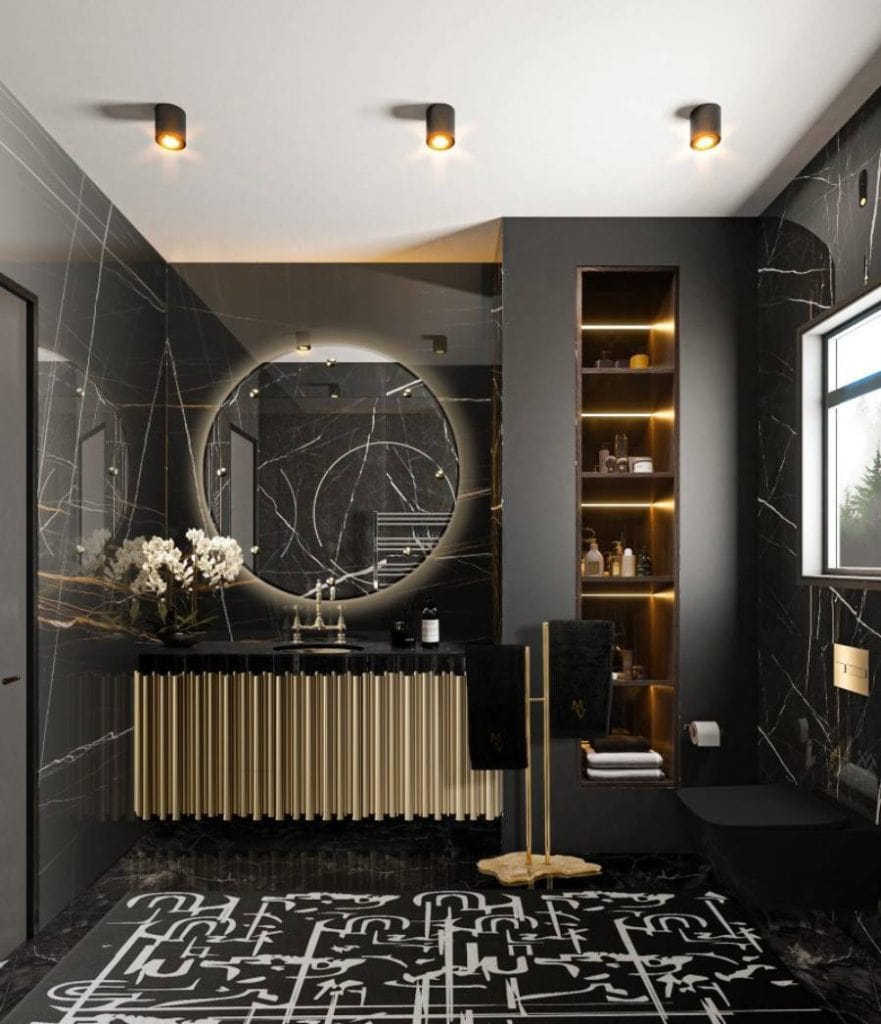
For those who prefer drama, black and gold create an opulent, almost cinematic atmosphere.
How It Feels: Powerful and sensual. The high contrast stimulates the eye, while the metallic warmth adds richness.
Design Tip: Use matte black tiles or fixtures and pair them with subtle gold highlights — like mirror trims or handles.
4. Parisian Elegance
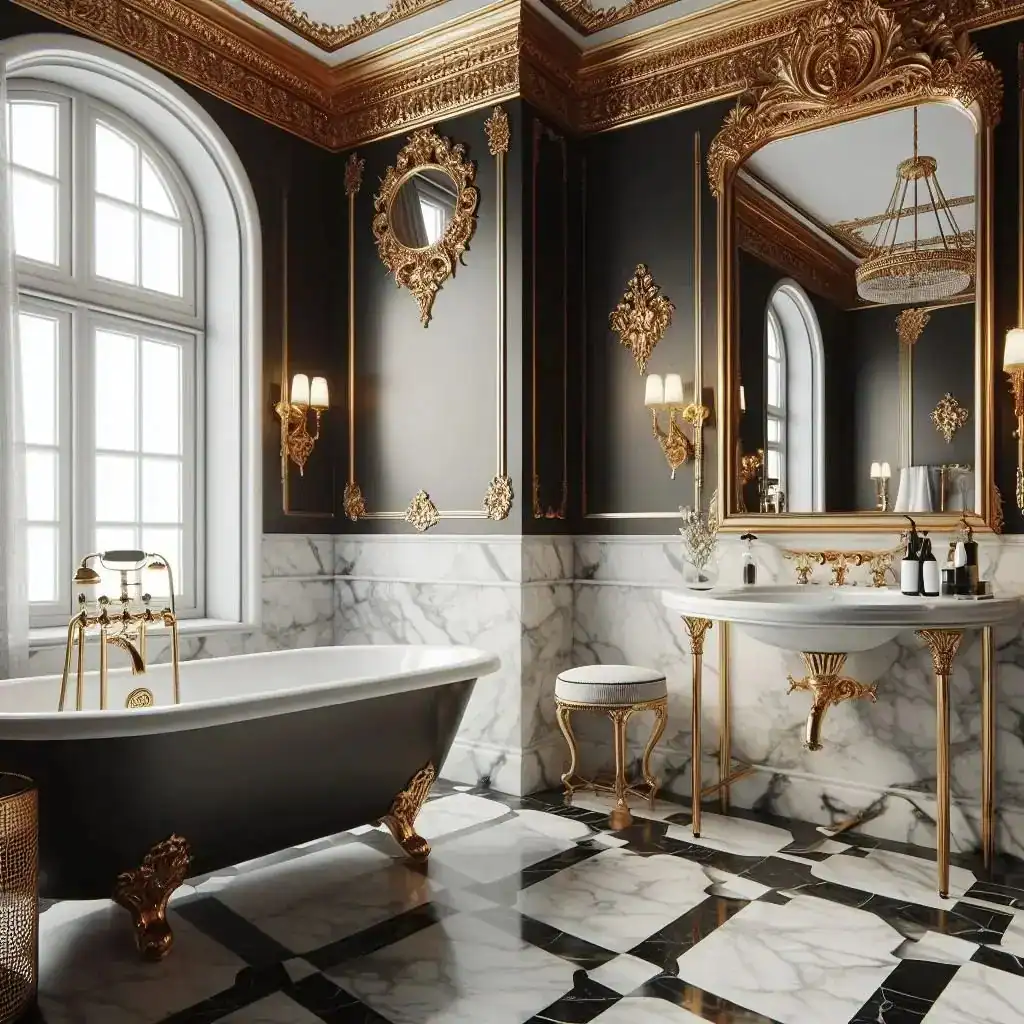
Parisian bathrooms blend tradition and grace. They feel timeless — never trendy.
Key Elements: Clawfoot tubs, marble vanities, ornate mirrors, and soft drapery.
Why It Works: It’s rooted in craftsmanship — nothing feels mass-produced. The space feels curated, layered, and personal.
Upgrade Trick: Replace standard cabinet hardware with antique brass knobs, or hang a gilded frame mirror for instant French charm.
5. Warm Minimalism

Luxury often hides in restraint. A warm minimalist bathroom uses clean lines and soft neutrals, but adds depth through materials.
Think: Floating oak vanities, linen shower curtains, and stone basins.
Why It Feels Expensive: Empty space lets quality breathe. You’re highlighting fewer but better things — a core rule of good design.
6. Nature Meets Luxury

This is where organic textures meet modern calm. Wood, stone, and water create a dialogue that feels deeply grounding.
Example: A slate floor, live-edge vanity, and skylight make even a small bathroom feel like a forest spa.
Tip: Choose warm, earthy colors (moss green, taupe, terracotta) and avoid anything too glossy.
7. High-Tech Haven

Luxury in 2025 is also smart. Motion-sensor faucets, built-in speakers, heated flooring, and programmable lighting combine comfort and convenience.
Why It Matters: Good design is about experience — how it feels to use the space.
Modern Must-Haves:
- Smart mirrors with LED and defog features
- Shower systems with multiple temperature zones
- Voice-activated lighting scenes (“Morning Glow,” “Evening Spa”)
8. Moody Glam
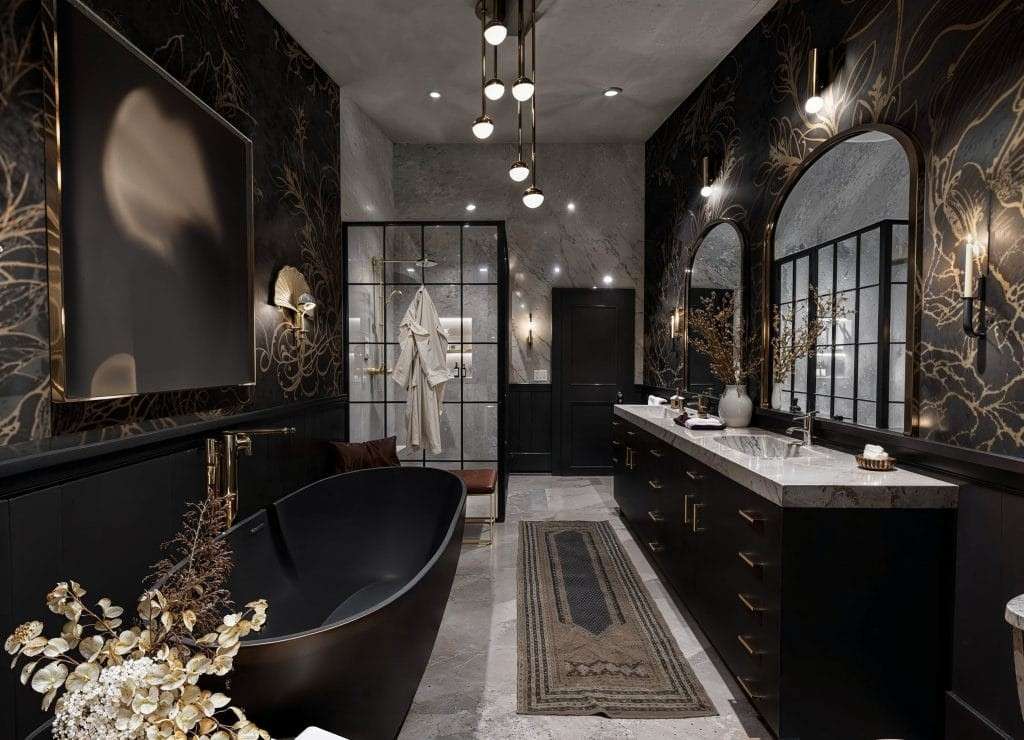
A rich, dark color palette — deep navy, graphite, or emerald — creates instant depth.
Styling Tip: Mix velvety finishes with metal or glass for contrast. Dark rooms crave reflection to keep light bouncing softly around.
For Smaller Spaces: Use darker tiles only halfway up the wall, then switch to a lighter tone. You’ll still get moodiness without making it cave-like.
9. Coastal Luxe Retreat

Not all luxury bathrooms are marble and gold. A coastal-inspired design feels airy and effortless, with a natural glow that mimics beach houses and high-end resorts.
Materials: White oak, rattan, linen, and marble.
Colors: Cream, driftwood, and sea-salt blue.
The Vibe: Calm, sunlit, timeless.
Lighting: The Secret Ingredient in Every Luxury Bathroom

If you take one thing from interior designers, it’s this — lighting can make or break a luxury look.
The best bathrooms layer three types:
- Ambient: Soft overhead light that fills the space.
- Task: Focused lighting near mirrors for grooming.
- Accent: Hidden LEDs under vanities or behind mirrors to add glow and dimension.
Warm color temperatures (2700–3000K) are key. Harsh white light can make even marble look sterile.
The Psychology of Luxury Bathroom Colors

Ever wondered why high-end spas never use bright colors?
Neutral and muted tones calm the mind. Beige, sand, and greige promote relaxation, while metallics signal sophistication.
Try This Palette: Warm white + taupe + aged brass. It feels both timeless and luxurious.
Common Questions About Luxury Bathrooms
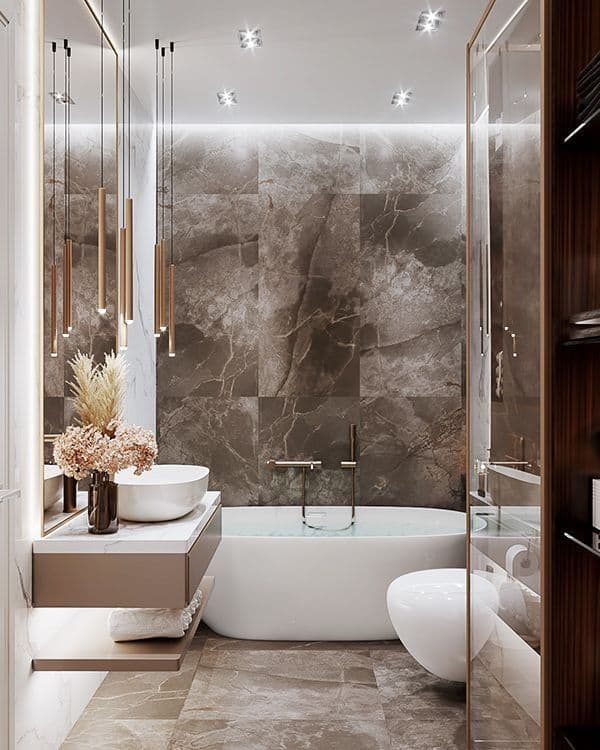
Q: How much does a luxury bathroom really cost?
A: Depending on size and finishes, between $15,000–$75,000+. But you can mimic the feel with smart swaps: stone-look porcelain instead of marble, brass-look hardware, and high-quality towels.
Q: What’s the biggest design mistake to avoid?
A: Overcrowding. Leave space to move. Luxury is as much about air as materials.
Q: Can small bathrooms feel luxurious?
A: Yes — focus on scale, not size. One beautiful feature (like a floating vanity or large mirror) is better than several small ones.
Finishing Touches That Define a Luxury Space
- Add a small art piece or sculpture — it tells a story.
- Keep towels thick, fluffy, and neutral.
- Include a scent ritual — a diffuser or candle with sandalwood, cedar, or white tea.
- Use trays to corral accessories; it creates visual order.
Final Thoughts
Luxury bathrooms don’t rely on wealth — they rely on intentional choices.
A good design engages your senses: sight, touch, scent, and sound. It’s the quiet confidence of a space that feels complete.
Whether you’re renovating or just restyling, start with one design principle from this guide. Layer slowly. Let the space evolve.
Because true luxury isn’t about impressing anyone — it’s about creating a place you can exhale.

I’m Katerina Lithopoulou, co-creator of DIY Cozy Living. I’ve always loved the little things that make a space feel special — soft textures, warm lighting, thoughtful details. With a background in language and a passion for photography and cozy design, I enjoy turning everyday inspiration into simple ideas people can actually use.
My motto: “Cozy isn’t a trend — it’s a feeling.”

